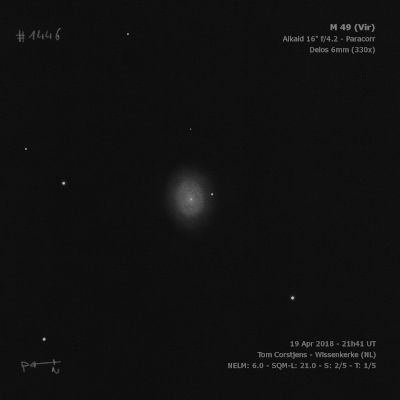
Charles Messier discovered M49 = NGC 4472 = H I-7 = h1294 on 19 Feb 1771 (first Virgo cluster member discovered). Oriani Independently found it on 22 Apr 1779 while following a comet that passed through the Virgo cluster. Admiral Smyth confused these discovery dates, causing later confusion on the primary discoverer.
William Herschel first recorded M49 on 23 Jan 1784 (early sweep 105) and described I-7 as "A beautiful nebula. Not cometic. It is visible in the finder and vB in the telescope", but his RA was 11 min too large. On 28 Dec 1785 (sweep 498) he called M49 "vB, cL, gmbM, extended with F branches." John Herschel made 5 observations, recording on sweep 253, "eB; L; R psmbM; insensibly fading away, has a * 13m following; by diag the star is just beyond the nebula." Heinrich d'Arrest claimed he resolved the cluster and saw "countless groups of stars; at 147x, the nebula periphery can be resolved into stars of the 13th and 14th magnitudes."
400/500mm - 17.5" (4/18/87): very bright, fairly large, sharp concentration to a compact very bright nucleus, large halo slightly elongated ~N-S fades at the edges. A mag 12 star is superimposed at the east edge 0.8' from center. A faint galaxy NGC 4467 lies 5' W.
900/1200mm - 48" (5/15/12): at 488x, M49 appeared extremely bright and large, slightly elongated N-S, ~6'x5', fades gradually so the outer extent may be larger. Well concentrated with an intense core that is sharply concentrated with a brilliant nucleus. A mag 12 star is superimposed 45" E of center. A number of galaxies (see below) surround the halo, including NGC 4467 4' W and NGC 4465 5.9' WNW. A mag 13 star is 4.6' W of center (close to NGC 4467).
VCC 1199, 4.5' NW of center, appeared faint, very small, round, 10" diameter.
VCC 1203, 4.6' SSW of center, is fairly faint, fairly small, round, 12" diameter, slightly brighter core. VCC 1203 is misidentified as NGC 4471 in SIMBAD. The NGC number probably applies to one of the two faint stars ~2' SE.
UGC 7636, 5.4' SE of center, is very faint, fairly small, elongated patch, ~0.5'x0.3' N-S, with a very low surface brightness and no concentration. This blue, dwarf irregular companion (Arp called it a "fragment") has been disrupted by M49 with H I gas stripped in a tidal tail.
Notes by Steve Gottlieb